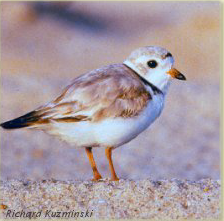Piping Plover
(Charadrius melodus)

If you ever see a pudgy shore bird with orange legs, an orange beak with a black tip, and a ring around its neck, that's the Piping Plover, in its breeding plumage. It tends to run in little bursts. They eat small crustaceans out of the sand and along the wrack line. They breed from Quebec to North Carolina in the summer, and winter from North Carolina to Florida. This little bird is quite popular among conservation-oriented people on the Atlantic coast, because it was put on the Endangered Species List in 1986, and is classifed as "threatened", meaning protection is needed to stop the decline. Most of the danger to the Piping Plover is through habitat loss. They nest in dunes and secluded beaches. Their nests and eggs blend into the sand and gravel, and are easily disturbed by predators such as foxes, cats, dogs, and gulls, as well as by humans being nearby. The adult Piping Plover will fake a broken wing to lead predators away from the nest, but this is always a risk for both the eggs or chicks as well as the parent. The best thing you can do to help plovers is obey signs indicating nesting areas near dunes and beaches, don't let pets wander off without leashes in nesting areas, and if you see a piping plover or its nest, give it some space. For more inforation on Piping Plover conservatiion, consult the U.S. Fish and Wildlife Service Piping Plover Atlantic Coast Population website.
Take me back to Species of the Week!Take me back to the Main Page!